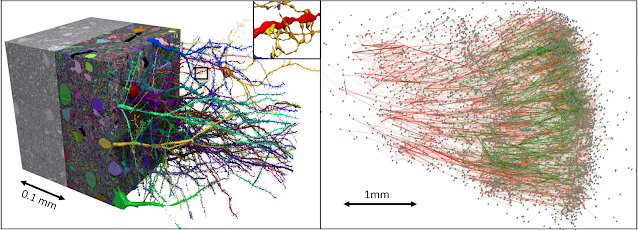This week Google freely released its ‘Brain Map‘, an incredibly and arguably the most detailed map ever published of the human brain.
It reveals an astonishing amount of detail, including patterns of connections between neurons, over 50,000 cells, all rendered in three dimensions, joined together by hundreds of millions of spidery tendrils (that’s the technical term), forming 130 million connections called synapses – it may have also revealed what could be a new kind of neuron. Viren Jain at Google Research compares this work to the the human genome project, which is still being explored 20 years after the first drafts were published, and the data set is so large that their team still haven’t looked at the detail it shows.

“H01” dataset accompanied by a companion paper that contains a 1.4-petabyte sample of human brain tissue (Source: Google)
This work was started by Jeff Lichtman, at Harvard University, and is all developed from a tiny piece of brain from a 45-year-old woman with drug-resistant epilepsy. This person had surgery to remove the left hippocampus, the source of her seizures, and then kindly donated it to Lichtman and his team. The sample was immersed in preservatives, stained with heavy metals like osmium, so the outer membranes of every cell were visible under an electron microscope. It was then embedded it in resin to toughen it. Finally, they cut it into slices around 30 nanometres thick, or about one-thousandth the width of a human hair, and used an electron microscope to image every slice. Jain’s team at Google, used these two dimensional images and how they were connected to form a three-dimensional volume, using machine learning to reconstruct the tendrils linking one neuron to another and labelled the different cell types.
“Its scale is best understood by thinking of a functional magnetic resonance imaging (fMRI) scan, used to show activity in different brain regions. The entire data set we produced is a cubic millimetre, which is usually one pixel in an MRI scan. It’s interesting to uncover all the stuff under the hood of one pixel of an MRI.” Viren Jain, Goole
The team has already made new discoveries about how our brain is wired: for example, there was a stark discrepancy in the numbers of connections between neurons. Normally, when a tendril from one neuron passed close to another, it would form just one synapse, or more rarely two to four. But there were also some tendrils that formed up to 20 synapses onto one target neuron, meaning this tendril by itself would probably be able to trigger that neuron to fire. The team also found mysterious pairs of neurons deep in the cortex that hadn’t been observed before. “The two cells pointed in exactly the opposite direction on the same axis,” says Lichtman. Nobody knows why.
Brain mapping has rapidly progressed since it was first started in the 1980s. Jain, Dulac and Lichtman were part of a group that, in 2020, argued in favour of mapping an entire mouse brain at a similar level of detail.
“A whole mouse brain is only 1000 times bigger than this, an exabyte instead of a petabyte. It’s on a scale where we probably will be able to do this within a decade, I suspect” says Lichtman. Dulac wants to see how the cortex links to other parts of the brain, and mapping the mouse brain would reveal that.
Mapping an entire human brain would need a data set that is a further 1000 times larger, a zettabyte, which Lichtman says is “comparable to the amount of digital content generated in a year by the planet Earth”.
But doing so might not be worthwhile. “We may discover that a lot of it is coding information that came in through experience, and therefore every brain will be something different from every other one,” he says. Without understanding how information is stored, the data would be gibberish, he says.
A more immediate benefit would be to explore how the cell map differs in people with mental health conditions, says Dulac. “Similar studies could be done in patients that also have some mental illness,” she says, to shed more light on how conditions like schizophrenia manifest.
Explore the Free Brain Map Here
Read more:

 Print This Post
Print This Post